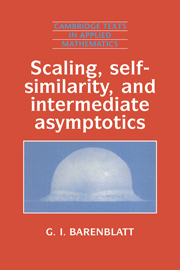 Scaling, Self-similarity, and Intermediate Asymptotics
Scaling, Self-similarity, and Intermediate Asymptotics Book contents
- Frontmatter
- Dedication
- Contents
- Preface
- Foreword
- Introduction
- 1 Dimensions, dimensional analysis and similarity
- 2 The construction of intermediate-asymptotic solutions using dimensional analysis. Self-similar solutions
- 3 Self-similarities of the second kind: first examples
- 4 Self-similarities of the second kind: further examples
- 5 Classification of similarity rules and self-similar solutions. A recipe for the application of similarity analysis
- 6 Scaling and transformation groups. Renormalization group
- 7 Self-similar solutions and travelling waves
- 8 Invariant solutions: asymptotic conservation laws, spectrum of eigenvalues, and stability
- 9 Scaling in the deformation and fracture of solids
- 10 Scaling in turbulence
- 11 Scaling in geophysical fluid dynamics
- 12 Scaling: miscellaneous special problems
- Afterword
- References
- Index
Foreword
Published online by Cambridge University Press: 18 December 2014
- Frontmatter
- Dedication
- Contents
- Preface
- Foreword
- Introduction
- 1 Dimensions, dimensional analysis and similarity
- 2 The construction of intermediate-asymptotic solutions using dimensional analysis. Self-similar solutions
- 3 Self-similarities of the second kind: first examples
- 4 Self-similarities of the second kind: further examples
- 5 Classification of similarity rules and self-similar solutions. A recipe for the application of similarity analysis
- 6 Scaling and transformation groups. Renormalization group
- 7 Self-similar solutions and travelling waves
- 8 Invariant solutions: asymptotic conservation laws, spectrum of eigenvalues, and stability
- 9 Scaling in the deformation and fracture of solids
- 10 Scaling in turbulence
- 11 Scaling in geophysical fluid dynamics
- 12 Scaling: miscellaneous special problems
- Afterword
- References
- Index
Summary
Professor Grigorii Isaakovich Barenblatt has written an outstanding book that contains an attempt to answer the very important question of how to understand complex physical processes and how to interpret results obtained by numerical calculations.
Progress in numerical calculation brings not only great good but also notoriously awkward questions about the role of the human mind. The human partner in the interaction of a man and a computer often turns out to be the weak spot in the relationship. The problem of formulating rules and extracting ideas from vast masses of computational or experimental results remains a matter for our brains, our minds.
This problem is closely connected with the recognition of patterns.lt is not just a coincidence that in both the Russian and English languages the word ‘obvious’ has two meanings – not only something easily and clearly understood, but also something immediately evident to our eyes. The identification of forms and the search for invariant relations constitute the foundation of pattern recognition; thus, we identify the similarity of large and small triangles, and so on.
Let us assume now that we are studying a certain process, for example a chemical reaction in which heat is released and whose rate depends on temperature. For a wide range of parameters and initial conditions, a completely definite type of solution is obtained – flame propagation. The chemical reaction occurs in a relatively narrow region separating the cold combustible substance from the hot combustion products; this region moves relative to the combustible substance with a velocity that is independent of the initial conditions. (Of course, the very occurrence of combustion depends on the initial conditions.)
This result can be obtained by direct numerical integration of the partial differential equations that describe the heat transfer, diffusion, chemical reaction, and (in some cases) hydrodynamics. Such a computational approach is difficult; the result is obtained in the form of a listing of quantities such as temperature and concentration as functions of temporal and spatial coordinates.
- Type
- Chapter
- Information
- Scaling, Self-similarity, and Intermediate AsymptoticsDimensional Analysis and Intermediate Asymptotics, pp. xvii - xxiiPublisher: Cambridge University PressPrint publication year: 1996
